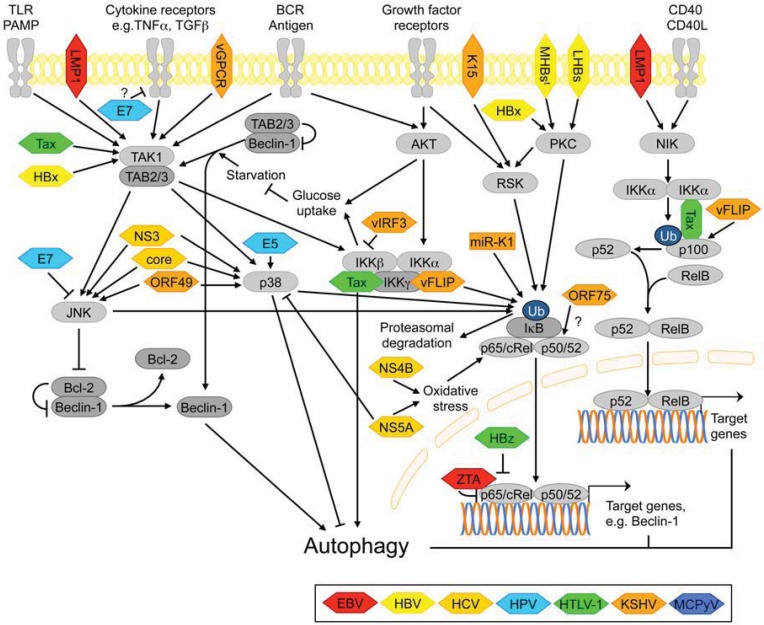Figure 4.
Autophagy regulation via the NF-κB pathway, and points of interference by viral proteins.
This figure gives a simplified overview of the cellular signaling pathways that regulate NF-κB transcription factors. These transcription factors function as homo- or heterodimers formed by the five proteins of the NF-κB/Rel-family: NF-κB1/p50, which is generated by proteolytic cleavage of its precursor p105 (omitted for clarity), NF-κB2/p52 generated by cleavage of the precursor p100, RelA/p65, RelB and c-Rel. The canonical NF-κB pathway is triggered by B-cell-, T-cell, cytokine-, growth factor- or Toll-like receptor signaling, which lead to activation of the inhibitor of κB kinase (IKK) complex in the cytoplasm. This complex consists of the catalytic subunits IKKα and IKKβ and the negative regulatory subunit IKKγ/NEMO (NF-κB essential modulator). IKK activation often also requires the transforming growth factor β-activated protein kinase 1 (TAK1). IKK complexes phosphorylate an inhibitor of κB (IκB) protein, which binds NF-κB dimers and retains them in the cytoplasm. Phosphorylation by IKKβ induces ubiquitination and proteasomal degradation of IκBs and releases NF-κB dimers, which subsequently undergo additional phosphorylation and acetylation events (omitted for clarity) and translocate to the nucleus to activate transcription of their target genes. Non-canonical NF-κB activation involves NF-κB-inducible kinase (NIK) mediated activation of IKKα homodimers, which then phosphorylate the NF-κB2/p100 precursor. This allows proteolytic processing of p100 to p52 which associates with RelB to form a functional transcription factor complex that enters the nucleus [229]. See main text for additional details and Figure 3 for additional autophagy-regulating pathways downstream of AKT and TAK1 and for upstream regulation of RSK. Specific tumor virus derived surface antigens/pathogen associate molecular patterns (PAMPs) activating the immune receptors shown in this figure have been omitted for clarity. Mechanistic details on how viral proteins interfere with NF-κB signaling have been included and are discussed in the text, except for the following: HTLV-1 Tax and KSHV vFLIP interact with IKKγ [266,267,268,269,270] and stimulate p100 expression and processing independently of NIK, whereas Tax may also directly interact with IKKα and p100 [271,272,273]. Question marks indicate that it is not clear at the moment where HPV E7 interferes with TNFα- and TGFβ-receptor signaling, and by which mechanism KSHV ORF75 activates NF-κB-dependent transcription. Light grey rounded rectangles-host cell kinases; light grey ovals-host cell transcription factors; dark grey rounded rectangles-other host cell proteins; colored hexagons-viral proteins; colored box-viral microRNA; : activation; to ⊥: inhibition. -: no general consensus in the literature on activation/inhibition; outcome may be cell type specific.

